
Expressionism - I
Expressionism
Expressionism is a modernist movement, initially in poetry and painting, originating in Northern Europe around the beginning of the 20th century. Its typical trait is to present the world solely from a subjective perspective, distorting it radically for emotional effect in order to evoke moods or ideas. Expressionist artists have sought to express the meaning of emotional experience rather than physical reality.
Expressionism developed as an avant-garde style before the First World War. It remained popular during the Weimar Republic, particularly in Berlin. The style extended to a wide range of the arts, including expressionist architecture, painting, literature, theatre, dance, film and music. Paris became a gathering place for a group of Expressionist artists, many of Jewish origin, dubbed the School of Paris. After World War II, figurative expressionism influenced artists and styles around the world.
The term is sometimes suggestive of angst. In a historical sense, much older painters such as Matthias Grünewald and El Greco are sometimes termed expressionist, though the term is applied mainly to 20th-century works. The Expressionist emphasis on individual and subjective perspective has been characterized as a reaction to positivism and other artistic styles such as Naturalism and Impressionism.
James Ensor
1860 - 1949
Baron James (Sidney Edouard) Ensor
(b Ostend, 13 April 1860; d Ostend, 19 Nov 1949).
Belgian painter, printmaker and draughtsman. No single label adequately describes the visionary work produced by Ensor between 1880 and 1900, his most productive period. His pictures from that time have both Symbolist and Realist aspects, and in spite of his dismissal of the Impressionists as ‘superficial daubers’ he was profoundly concerned with the effects of light. His imagery and technical procedures anticipated the colouristic brilliance and violent impact of Fauvism and German Expressionism and the psychological fantasies of Surrealism. Ensor’s most memorable and influential work was almost exclusively produced before 1900, but he was largely unrecognized before the 1920s in his own country. His work was highly influential in Germany, however: Emil Nolde visited him in 1911, and was influenced by his use of masks; Paul Klee mentions him admiringly in his diaries; Erich Heckel came to see him in the middle of the war and painted his portrait (1930; Cologne, Wallraf-Richartz-Mus.); Alfred Kubin owned several of his prints, while Marc Chagall and George Grosz also adapted certain elements from Ensor. All the artists of the Cobra group saw him as a master. He influenced many Belgian artists including Léon Spilliaert, Rik Wouters, Constant Permeke, Frits van den Berghe, Paul Delvaux and Pierre Alechinsky.

James Ensor
Self-Portrait with Masks (1899)

James Ensor
Old Woman with Masks
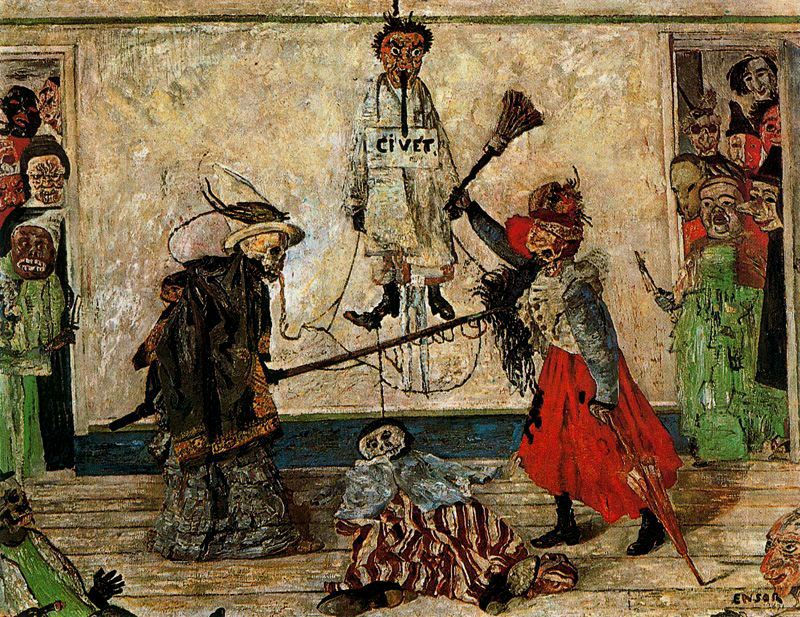
James Ensor
Masks Fighting over a Hanged Man

James Ensor
The Astonnishment of the Masks Wouse

James Ensor
Christ's Entry Into Brussels in 1889
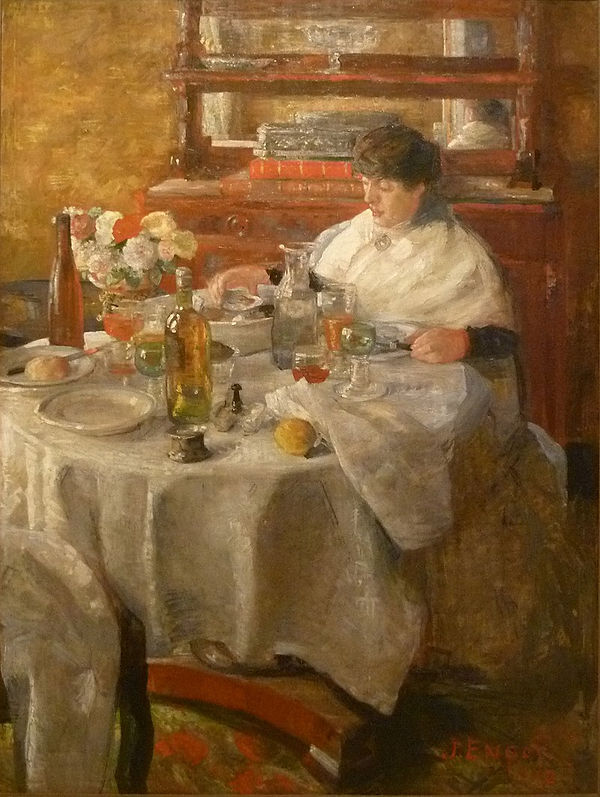
James Ensor
The Oyster Eater (1882)

James Ensor
Scandalized Mask (1883)

James Ensor
Tribulations of Saint Anthony (1887)

James Ensor
Skeletons Warming Themselves (1889)

James Ensor
Attributes of the Studio (1889)

James Ensor
The Intrigue (1890)

James Ensor
The Good Judges (1891)

James Ensor
The Man of Sorrows (1891)

James Ensor
Still Life with Chinoiseries (c. 1906)

James Ensor
Still Life with a Cabbage (1921)
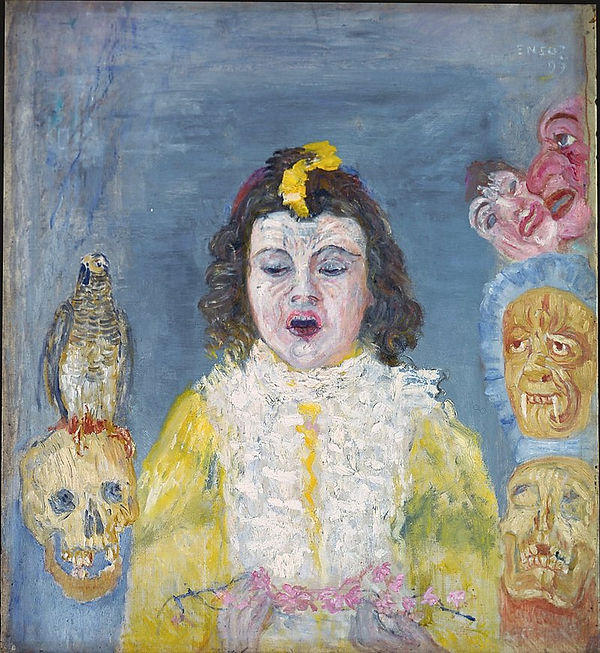
James Ensor
Girl with Masks or Eucharist (1921)

James Ensor
Ensor at the Harmonium (1933)

James Ensor
King Pest (1895)

James Ensor
Old Woman with Masks

James Ensor
Pride (1904)

James Ensor
Gluttony (1904)
Edvard Munch
1863 - 1944
Edvard Munch
(12 December 1863 – 23 January 1944) was a Norwegian painter. His best known work, The Scream (1893), has become one of Western art's most iconic images.
His childhood was overshadowed by illness, bereavement and the dread of inheriting a mental condition that ran in the family. Studying at the Royal School of Art and Design in Kristiania (today's Oslo), Munch began to live a bohemian life under the influence of the nihilist Hans Jæger, who urged him to paint his own emotional and psychological state ('soul painting'); from this emerged his distinctive style.
Travel brought new influences and outlets. In Paris, he learned much from Paul Gauguin, Vincent van Gogh and Henri de Toulouse-Lautrec, especially their use of color. In Berlin, he met the Swedish dramatist August Strindberg, whom he painted, as he embarked on a major series of paintings he would later call The Frieze of Life, depicting a series of deeply-felt themes such as love, anxiety, jealousy and betrayal, steeped in atmosphere.
The Scream was conceived in Kristiania. According to Munch, he was out walking at sunset, when he 'heard the enormous, infinite scream of nature'. The painting's agonized face is widely identified with the angst of the modern person. Between 1893 and 1910, he made two painted versions and two in pastels, as well as a number of prints. One of the pastels would eventually command the fourth highest nominal price paid for a painting at auction.
As his fame and wealth grew, his emotional state remained insecure. He briefly considered marriage, but could not commit himself. A mental breakdown in 1908 forced him to give up heavy drinking, and he was cheered by his increasing acceptance by the people of Kristiania and exposure in the city's museums. His later years were spent working in peace and privacy. Although his works were banned in Nazi-occupied Europe, most of them survived World War II, securing him a legacy.

Munch
Self-Portrait
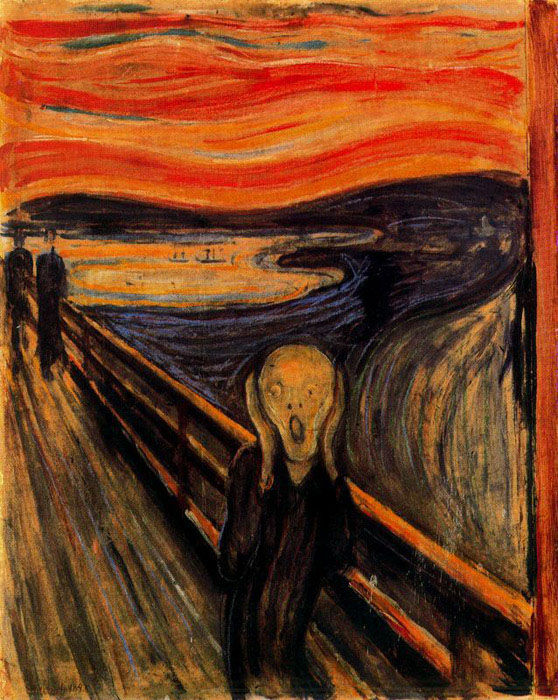
Munch
The Scream

Munch
Rojo y blanco

Munch
Women on the Beach
1898

Munch
Los solitarios

Munch
Encounted in Space
1899

Munch
Golgotha

Munch
The Sick Child

Munch
Spring
1889

Munch
Madonna

Munch
Madonna

Munch
Puberty

Munch
Vampire

Munch
Anna

Munch
The Beast

Munch
Muchacha bostezando

Munch
Model by the Wicker Chair
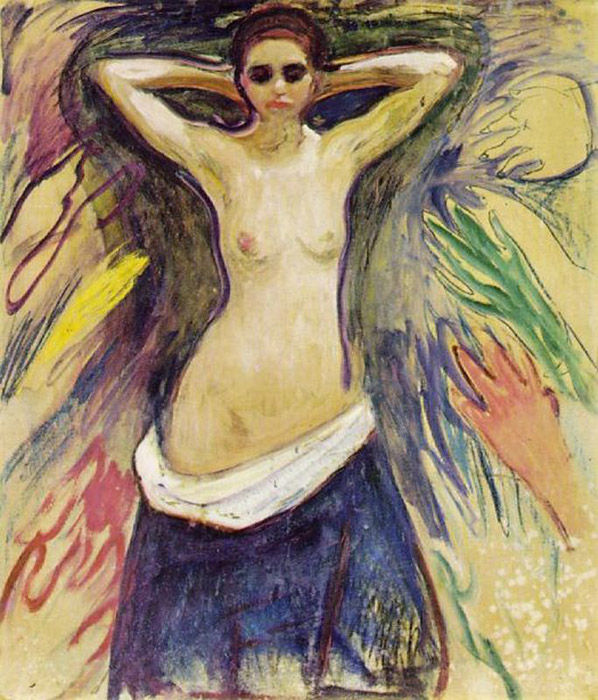
Munch
The Hands

Munch
Spring Evening on Karl Johan Street, Oslo

Munch
The Day After

Munch
Anxiety

Munch
Ashes

Munch
Melancholia

Munch
The Dance of Life

Munch
Girls on the Jetty
1901

Munch
The Dead Mother
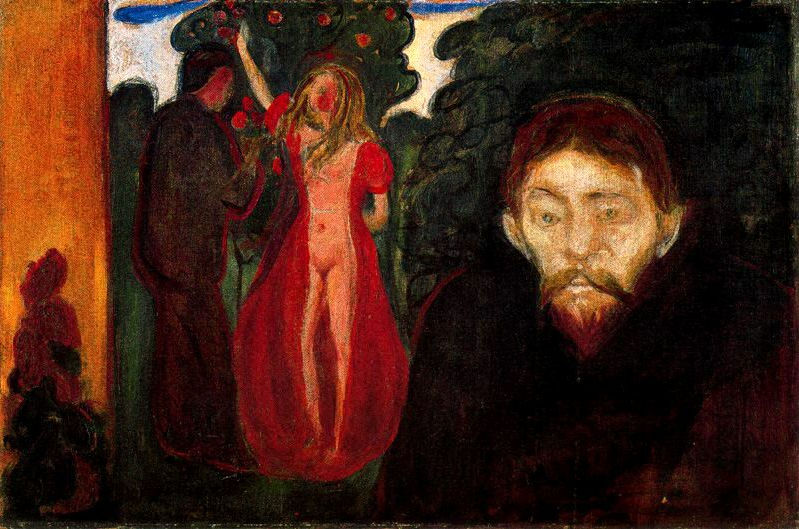
Munch
Jealousy

Munch
Hombre y mujer

Munch
Women in Three Stages

Munch
Self-Portrait Between Bed and Clock
1940
Louis Legrand
1863 – 1951
Louis Auguste Mathieu Legrand
(29 September 1863 – 1951) was a French artist, known especially for his aquatint engravings, which were sometimes erotic. He was awarded the Légion d'honneur for his work in 1906.
Legrand was born in the city of Dijon in the east of France. He worked as a bank clerk before deciding to study art part-time at Dijon's Ecole des Beaux-Arts. He won the Devosge prize at the school in 1883. In 1884 Legrand studied engraving under the Belgian printmaker Félicien Rops.
Legrand's artworks include etchings, graphic art and paintings. His paintings featured Parisian social life. Many were of prostitutes, dancers and bar scenes, which featured a sense of eroticism. According to the Hope Gallery, "Louis Legrand is simply one of France's finest early twentieth century masters of etching." His black and white etchings especially provide a sense of decadence; they have been compared to those of Henri de Toulouse-Lautrec, though his drawings of the Moulin Rouge, the can-can dance and the young women of Montmartre preceded Toulouse-Lautrec's paintings of similar scenes. He made over three hundred prints of the night life of Paris. They demonstrate "his remarkable powers of observation and are executed with great skill, delicacy, and an ironic sense of humor that pervades them all."
Two of his satirical artworks caused him to be tried for obscenity. The first, "Prostitution" was a symbolic drawing which depicted a naked girl being grasped by a dark monster which had the face of an old woman and claws on its hands; the second, "Naturalism", showed the French novelist Émile Zola minutely studying the thighs of a woman with a magnifying glass. Defended by his friend the lawyer Eugène Rodrigues-Henriques (1853–1928), he was found not guilty in the lower court, but was convicted in the appeal court and then given a short prison sentence for refusing to pay his fine.


Louis Legrand. Elégante à l'éventail, c. 1900
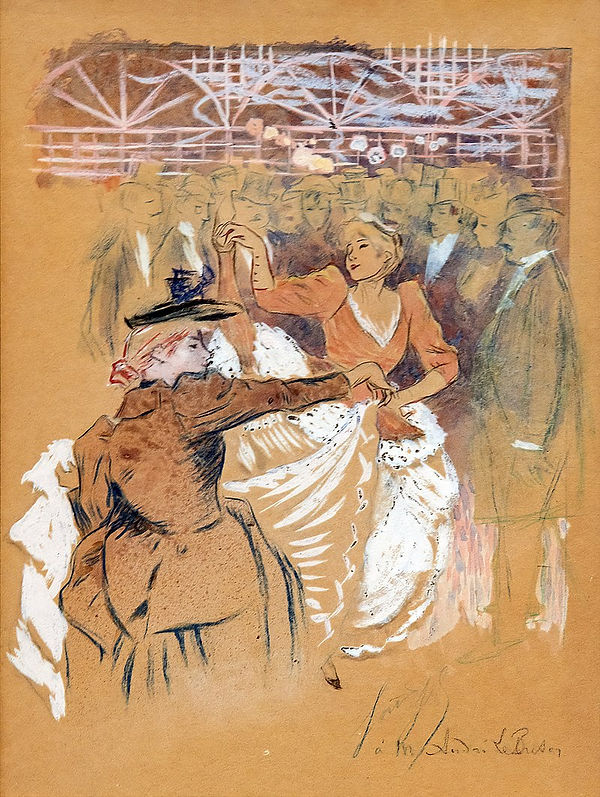
Louis Legrand. Le Cancan au bal Bullier, c. 1895

Louis Legrand. Désespoir

Louis Legrand. etching of young couple embracing in parlor

Louis Legrand. La Loge

Louis Legrand. Livry-Gargan: Paresseuse.
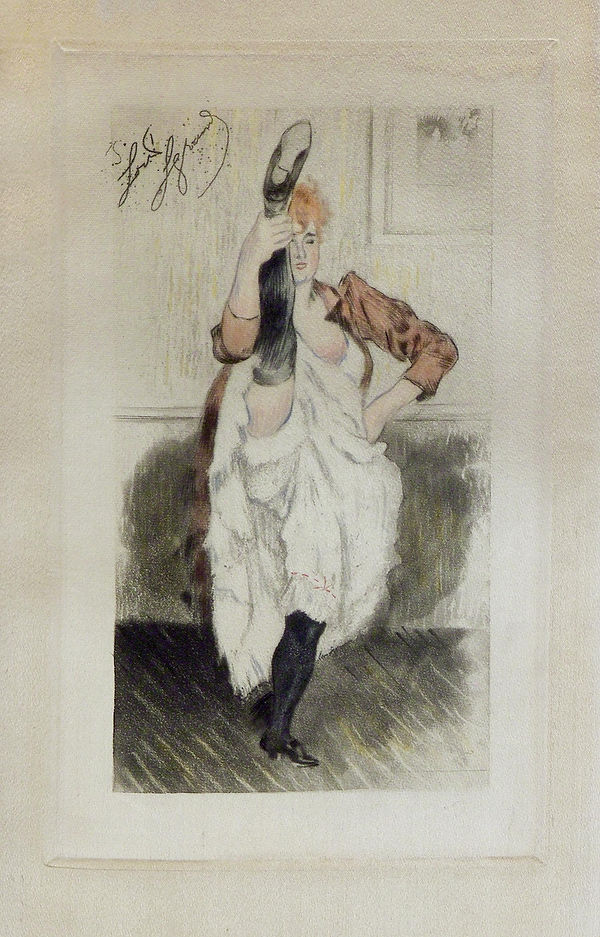
Louis Legrand. Cours de Danse

Louis Legrand. Paysage breton

Louis Legrand. Coquettierie (Femme au Miroir)

Louis Legrand. France

Louis Legrand. "Le Pochard"

Louis Legrand. La Toilette

Louis Legrand. La Toilette

Louis Legrand. "Le Deshabillage (Undressing)"

Louis Legrand. Mutter mit Kind.

Louis Legrand. „Baigneuse“.

Louis Legrand. La Toilette

Louis Legrand. La pause musicale

Louis Legrand. L’heure du thé

Louis Legrand. Untitlet.

Louis Legrand. LA DIVINE PAROLE

Louis Legrand. Le Livre d'Heures

Louis Legrand. DEVANT LA FENÊTRE

Louis Legrand. Le Cadre.

Louis Legrand. Ensemble de trois estampes
Alexej von Jawlensky
1864 - 1941
Alexej Georgewitsch von Jawlensky
(13 March 1864 – 15 March 1941), surname also spelt as Yavlensky, was a Russian expressionist painter active in Germany. He was a key member of the New Munich Artist's Association (Neue Künstlervereinigung München), Der Blaue Reiter (The Blue Rider) group and later the Die Blaue Vier (The Blue Four).

Selbstbildnis Alexej von Jawlenskij.

Alexei Jawlensky - Young Girl with a Flowered Hat, 1910

Alexei Jawlensky - Schokko with Red Hat, 1909

Alexei Jawlensky - Portrait of Alexander Sakharoff, 1909

Alexei Jawlensky - Schokko with Wide Brimmed Hat, 1910

Alexei Jawlensky - Violet Turban, 1911

Alexei Jawlensky - Head of a youth, 1911

Alexei Jawlensky - Head in Blue, 1912

Alexei Jawlensky - Brown curls, 1913

Alexei Jawlensky - Savior's Face: Martyr, 1919

Alexei Jawlensky - Astonishment, 1919

Alexei Jawlensky - Medusa, 1923
Emil Nolde
1867 - 1956

Emil Nolde. Self-Portrait
Emil Nolde
(born Hans Emil Hansen; 7 August 1867 – 13 April 1956) was a German-Danish painter and printmaker. He was one of the first Expressionists, a member of Die Brücke, and was one of the first oil painting and watercolor painters of the early 20th century to explore color. He is known for his brushwork and expressive choice of colors. Golden yellows and deep reds appear frequently in his work, giving a luminous quality to otherwise somber tones. His watercolors include vivid, brooding storm-scapes and brilliant florals.
Nolde's intense preoccupation with the subject of flowers reflected his interest in the art of Vincent van Gogh.
Even though his art was included in the Entartete Kunst exhibition of 1937, Nolde was a racist, anti-semite and a staunch supporter of Nazi Germany.
Nolde was a supporter of the National Socialist German Workers' Party from the early 1920s, having become a member of its Danish section. He expressed anti-semitic, negative opinions about Jewish artists, and considered Expressionism to be a distinctively Germanic style. This view was shared by some other members of the Nazi party, notably Joseph Goebbels and Fritz Hippler.
However, Adolf Hitler rejected all forms of modernism as "degenerate art", and the Nazi regime officially condemned Nolde's work. Until that time he had been held in great esteem in Germany. A total of 1,052 of his works were removed from museums, more than those of any other artist. Some were included in the Entartete Kunst exhibition of 1937, despite his protests, including (later) a personal appeal to Nazi Gauleiter Baldur von Schirach in Vienna. He was not allowed to paint—even in private—after 1941. Nevertheless, during this period he created hundreds of watercolors, which he hid. He called them the "Unpainted Pictures".
After World War II, Nolde was once again honoured, receiving the Pour le Mérite.
While acknowledging his success as a brilliant colourist, greater awareness of Nolde's commitment to Nazism and a discussion of the relationship between his politics, denunciation of non-Jewish adversaries as Jews, and his art is considered in more recent scholarship. A recent exhibition (Emile Nolde: A German Legend, The Artist during the Nazi Regime, Berlin National Gallery, 2019) examined Nolde's self-professed Nazi leanings, and the tendency of postwar art historians to downplay them.
He died in Seebüll, now part of Neukirchen, in 1956.

Pentecost
Emil Nolde
1909

The Last Supper
Emil Nolde
1909

Dance Around the Golden Calf
Emil Nolde
1910

Mask Still Life III
Emil Nolde
1911

At the Café
Emil Nolde
1911

Burial
Emil Nolde
1915

Women and Pierrot
Emil Nolde
1917

Flower garden (marigolds)
Emil Nolde
1919

Young Couple
Emil Nolde
1935

Excited People
Emil Nolde

Colored sky above the Marais
Emil Nolde
c.1940
Georges Rouault
1871 — 1958
Rouault Georges
(1871 — 1958). French painter, born in Pans; apprenticed as a craftsman in stained glass. He studied painting in G. *Moreau's studio (1892—8) and on Moreau's death (1898) became curator of the Mus. Moreau, a post he held until his own death. His early religious paintings reflect both the jewel-like character of Moreau's art and his own taste for medieval art. His intense religiosity was heightened by his contacts with Huysmans and with Leon Bloy whose passionate Catholic novels of sordid Parisian life prompted the Prostitute series of 1903—7: e.g. At the Mirror (1906). Superficially close to Lautrec in subject and technique, these were the crudely painted images that linked R.'s name with the *Fauves at the 1905 Salon d'Automne. But 1in1 fact these pictures were conceived as moralities of sin and redemption foreshadowing the intensely religious character of his mature style. This placed, in common with contemporary German *Expressionist painting, great emphasis on the direct expression of emotion. He concentrated on graphic work (1916—29), and these prints — particularly the Guerre ct Miserere etchings — are his most Expressionist works. His paintings, laboriously painted and with a heavy black outline reminiscent of the lead in stained glass, are the more profound hieratic images which made him the foremost religious artist of the c. He designed stained-glass windows for a church at Assy (1948).

Georges Rouault, Self-Portrait
1926

Georges Rouault, 1905, Jeu de massacre (Slaughter), (Forains, Cabotins, Pitres), (La noce à Nini patte en l'air)

Georges Rouault, Nude with Raised Arm1906

Georges Rouault, Ballet Dancer1906

Georges Rouault, Nackte Frau in der Landschaft1906

Georges Rouault, Les Filles1907

Georges Rouault, Nu au miroir1907

Georges Rouault, August from Cirque de L'etoile Filant

Georges Rouault, Are we not all convicts?1926

Georges Rouault, Homo homini lupus
1926

Georges Rouault, Danse Macabre
1926

Georges Rouault, Miserere

Georges Rouault, Le Clown a la Grosse Caisse
1930

Georges Rouault, La Parade
1930

Georges Rouault, Dors Mon Amour
1935

Georges Rouault, Madame Louison
from the series "Cirque de l'Etoile Filante"
1935

Georges Rouault, Madame Carmencita
1935
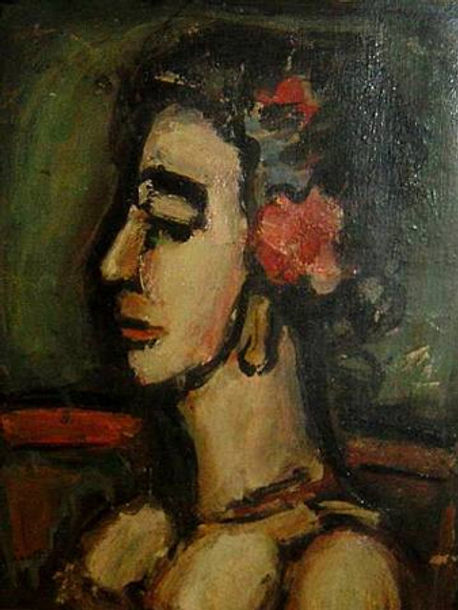
Georges Rouault, Brigitte
1937

Georges Rouault, The Old King
1937

Georges Rouault, Automne
1938

Georges Rouault, Tete d'une jeune fille
1939

Georges Rouault, Gerant de cirque avec une saltimbanque
1941

Pierrots bleus au bouquet
Georges Rouault
1946
Lyonel Feininger
1871 – 1956

Lyonel Charles Feininger
(July 17, 1871 – January 13, 1956) was a German-American painter, and a leading exponent of Expressionism. He also worked as a caricaturist and comic strip artist. He was born and grew up in New York City, traveling to Germany at 16 to study and perfect his art. He started his career as a cartoonist in 1894 and met with much success in this area. He was also a commercial caricaturist for 20 years for magazines and newspapers in the USA and Germany. At the age of 36, he started to work as a fine artist. He also produced a large body of photographic works between 1928 and the mid 1950s, but he kept these primarily within his circle of friends. He was also a pianist and composer, with several piano compositions and fugues for organ extant.
Self-Portrait
Lyonel Feininger
1915

The Newspaper Readers
Lyonel Feininger
1909

In a Village Near Paris (Street in Paris, Pink Sky)
Lyonel Feininger
1909

Carnival in Arcueil
Lyonel Feininger
1911

The White Man
Lyonel Feininger
1907

Lady in Mauve
Lyonel Feininger
1922

Jesuiten III (Jesuits III)
Lyonel Feininger
1915

Yellow Street II
Lyonel Feininger
1918

Werther I
Lyonel Feininger
1916

Landungssteg
Lyonel Feininger
1920

The Cathedral
Lyonel Feininger
1920

Lyonel Feininger, 1914, Benz VI

Lyonel Feininger, 1924, Gaberndorf II

The Dome in Halle
Lyonel Feininger
1930

Lunar Web
Lyonel Feininger
1951
Paula Modersohn-Becker
1876 – 1907

Paula Modersohn-Becker (8 February 1876 – 20 November 1907) was a German Expressionist painter of the late 19th and early 20th century. Her work is noted for its intensity and its blunt, unapologetic humanity, and for the many self-portraits the artist produced, including nude self-portraits. She is considered one of the most important representatives of early expressionism, producing more than 700 paintings and over 1000 drawings during her active painting life. She is recognized both as the first known woman painter to paint nude self-portraits, and the first woman to have a museum devoted exclusively to her art (the Paula Modersohn-Becker Museum, founded 1927). Additionally, she is considered to be the first woman artist to depict herself both pregnant and nude and pregnant.
Her career was cut short when she died from postpartum embolism at the age of 31.
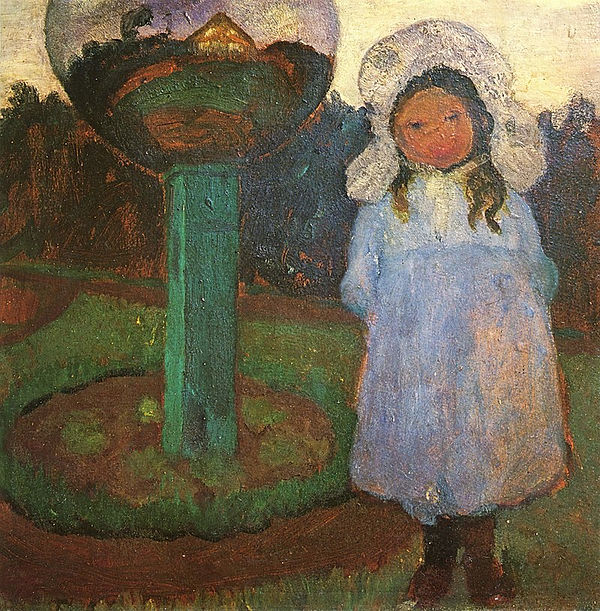
Paula Modersohn-Becker, Girl in a Garden Next to a Glass Sphere (1901-2)

Paula Modersohn-Becker, Child with Goldfish (1907)

Paula Modersohn-Becker, Rainer Maria Rilke (1906)

Paula Modersohn-Becker, Reclining Mother and Child (1906)

Paula Modersohn-Becker, self-portrait

Paula Modersohn-Becker - Still life with oranges and stoneware dog

Paula Modersohn-Becker. Self-Portrait on the 6th Wedding Anniversary (1906)

Paula Modersohn-Becker - Elsbeth Modersohn with a rabbit (1905)